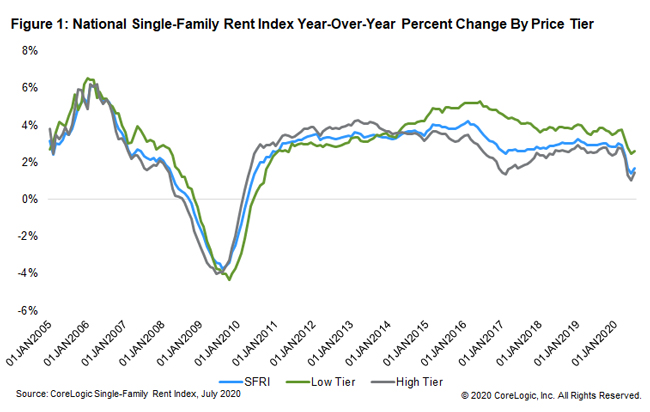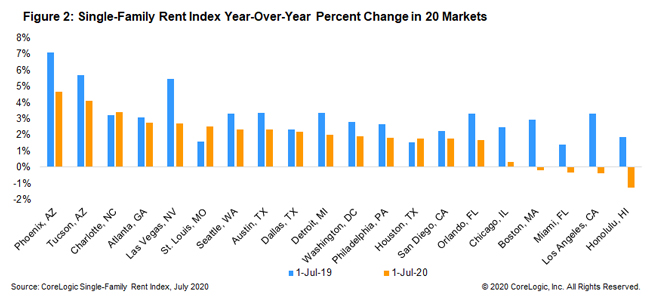
Source: https://www.corelogic.com/blog/2020/9/us-single-family-rent-growth-stabilized-at-a-low-level.aspx
U.S. Single-Family Rents Up 1.7% Year Over Year in July
U.S. single-family rent growth stabilized in July, increasing 1.7% year over year, a bit higher than the 1.4% rate reported for June 2020, and a sharp slowdown from the 2.9% rate recorded for July 2019, according to the CoreLogic Single-Family Rent Index (SFRI). The index measures rent changes among single-family rental homes, including condominiums, using a repeat-rent analysis to measure the same rental properties over time.
Figure 1: National Single-Family Rent Index Year-Over-Year Percent Change By Price Tier

Lower-priced rentals continued to prop up national rent price growth, which has been an ongoing trend since April 2014 (Figure 1). However, year-over-year growth among both tiers slowed in July 2020. Rent prices for the low-end tier, defined as properties with rent prices less than 75% of the regional median, increased 2.6% year over year in July 2020, down from 3.7% in July 2019. Meanwhile, higher-priced rentals, defined as properties with rent prices greater than 125% of a region’s median rent, increased 1.4% in July 2020, down from a gain of 2.5% in July 2019
Figure 2: Single-Family Rent Index Year-Over-Year Percent Change in 20 Markets

Figure 2 shows the year-over-year change in the rental index for 20 large metropolitan areas in July 2020. Among the 20 metro areas shown, Phoenix had the highest year-over-year rent growth this July as it has since late 2018, with an increase of 4.7%, followed by Tucson (+4.1%) and Charlotte (+3.4%). Four metro areas experienced annual declines in rent prices: Honolulu (-1.3%), Los Angeles (-0.4%), Miami (-0.3%) and Boston (-0.2%). Los Angeles had the largest deceleration in rent growth in July, showing annual rent growth of 3.7 percentage points lower than in July 2019. U.S. unemployment rates remain elevated and the nation had 7.7% fewer jobs in July 2020 than a year earlier. However, some areas of the country are continuing to experience higher rates of job loss — adversely impacting rental demand and slowing rent price growth. For example, Honolulu and Las Vegas experienced large annual drops in employment, falling 13.8% and 12.6% respectively. Meanwhile, employment declines in Phoenix (-3.5%) and Tucson (-3.6%) were smallest amongst the 20 metros covered in the report. With the continued resurgence of COVID-19 cases across the country, we may expect to see further disruption of local rental markets.
To learn more about the data behind this article and what CoreLogic has to offer, visit https://www.corelogic.com/.







Sign up to receive our stories in your inbox.
Data is changing the speed of business. Investors, Corporations, and Governments are buying new, differentiated data to gain visibility make better decisions. Don't fall behind. Let us help.













Sign up to receive our stories in your inbox.
Data is changing the speed of business. Investors, Corporations, and Governments are buying new, differentiated data to gain visibility make better decisions. Don't fall behind. Let us help.





